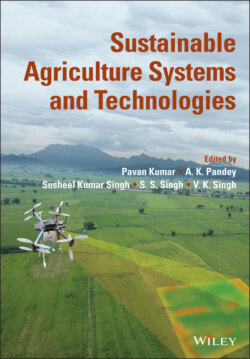Читать книгу Sustainable Agriculture Systems and Technologies - Группа авторов - Страница 20
1.3 Dynamics of Under Nutrition in India
ОглавлениеHunger is measured considering children under five years who are under nourished, stunted, wasted, underweight, and under‐five mortality rate. Stunting means the percentage of children under five years who are stunted (height to age) is presented in Figure 1.2a from data obtained from National Family Health Survey (NFHS) 4. It shows that the highest prevalence of stunting is seen in Bihar, Uttar Pradesh, Jharkhand, Meghalaya, and Madhya Pradesh with more than 40% of children stunted, while Kerala, Goa, and Tripura have less than 25% of children stunted. Lessons can be taken from these states to improve the status in other states. Also, regional disparities were observed with higher percentage of stunting in rural area as compared to urban area. This is subject to the reasons that sanitation, antenatal care, and literacy are higher in the urban side. This means, emphasis on improvement of these parameters can help uplift the children from malnutrition.
Child wasting means low weight for height and indicates the acute food shortage or prevalence of disease in children (UNICEF). As per NFHS 4 Jharkhand, Gujarat, Karnataka, Madhya Pradesh, and Maharashtra, more than 23% of children are wasted (Figure 1.2b), while Mizoram and Manipur have less than 10% wasted children. The reasons can be similar to the reasons of stunting. There is 50% chance that a stunted child will also be wasted. The urban rural divide is prevalent in this case too. Hunger also leads to underweight children and if prolonged it leads to mortality of children. As seen in Figure 1.2c, in Madhya Pradesh, Jharkhand, and Bihar more than 40% of children are underweight, while Manipur, Mizoram, and Sikkim have less than 15% underweight population of children under five years. This shows strong association between stunting, wasting, and underweight of children as Madhya Pradesh, Jharkhand, and Bihar have the highest prevalence of all these parameters. Under five infant mortality is highest in Uttar Pradesh, Madhya Pradesh, and Chhattisgarh, i.e. more than 60 deaths per 1000 lives (Figure 1.2d). This reveals that Madhya Pradesh, Bihar, Uttar Pradesh, and Jharkhand have the highest level of malnourishment in India. Combining all the four parameters, we see that Madhya Pradesh, Bihar, Uttar Pradesh, and Jharkhand have the highest level of undernourishment in India. An insight into the economy of these states shows that Madhya Pradesh has 62% of labor force participation in agriculture and agriculture contributes 45% to the Gross State Value Added (GSVA) (Madhya Pradesh Budget Analysis 2019–20 ). Uttar Pradesh, the most populous state of India (17.11%) is the leading producer of food grains in India (Agricultural Statistics at a Glance 2018). Jharkhand is a rural state with 76% of its population living in rural area. And almost 49% of its population lives below poverty line. Bihar has 23% of its GSVA to the state's economy by agriculture (Bihar Budget Analysis 2019‐20). Apart from this out of total labor force the casual labor force of Bihar is 32.2%, Jharkhand 23.6%, Madhya Pradesh 28.2%, and Uttar Pradesh 21.3% and they are not able to find job after COVID‐19 outbreak. Percentage of population below poverty line of Bihar is 33.7%, Jharkhand 36.7%, Madhya Pradesh 31.7%, and Uttar Pradesh 29.4% and Uttar Pradesh has 17.12% of population, while Bihar, Madhya Pradesh, and Jharkhand comprise of 9, 6, and 3% of population, i.e., 35% of the population of India. These states are mainly agriculture dependent making the population more vulnerable. Madhya Pradesh and Uttar Pradesh being highly populous states in spite of having high number of beneficiaries under Integrated Child Development Scheme are still among the poor performers. This implies that unequal distribution of income might be the reason that despite economic growth and food production, prevalence of hunger is there.
Figure 1.2 Status of undernutrition in India. (a) Prevalence of stunted children. (b) Prevalence of child wasting. (c) Prevalence of underweight children. (d) Under‐five mortality rate.
Source: Based on NFHS 2015–16 .
(See insert for color representation of the figure.)
